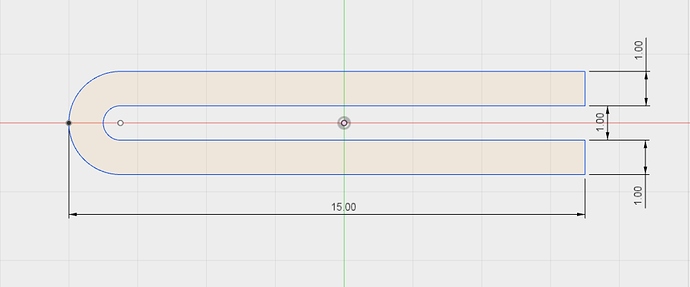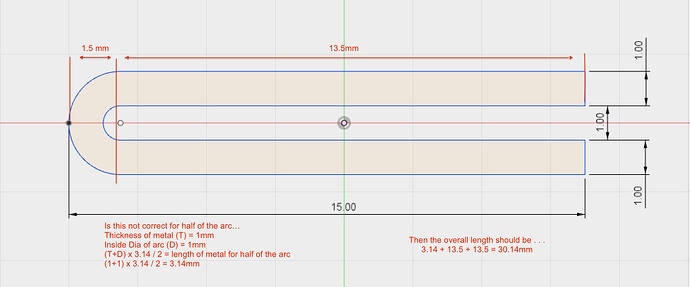How do I calculate the length of this when it is laid flat?
Is this wire, sheet or ribbon.
-----Original Message-----
This is sterling sheet.
I am sure that there is a formula, but make it out of copper sheet, unbend it and measure it. Add a bit to file…Rob
You have 1/2 of a ring and two long ends:
Ring formula: (diameter (1mm) + sheet thickness (1mm)) x pi = 2 x 3.14159 = ~6.283mm / 2 since you only need half (as the bend is only 1/2 of the “ring”)= ~3.142mm
Plus the two tails: 2 x total length (15mm) - the distance taken by the bend, which in this case (as you can see in the diagram) is 1.5mm (1 radius + 1 sheet thickness): 2 x 13.5mm = 27mm
So I would try something like 30.15mm in copper and see if that’s right (because I could be wrong, as I’m away from my bench and can’t test this myself). If so, you should be able to apply this formula to any this shape with different values for overall length, bend diameter and metal thickness.
Hope this works for you!
-Matthew
I’m not sure if you’re looking for the length through the middle of the drawing, or one of the inner or outer lengths, but all are pretty straightforward.
Let’s first look at the “inner archway”. It consists of two segments of length (15 - 1 - .5) and one semicircle of circumference 2pir/2 where r = .5.
So the inner arch way has length 2 * 13.5 + pi/2 = 28.6
Now let’s look at the outer archway.
It also has two segments of length 13.5, but its semicircle has circumference of 2pir/2 where r = 1.5.
So the outer arch way has length 2 13.5 + 3/2pi = 31.7
For the middle, you could average the two
This is interesting, I getting answers from 31.7 mm, 31.5, 34.7, 30.15 and my answer 30.14… Here is my math. where am I going wrong?
I don’t think I under stand the question. If it is sheet it is 3" x15". If you are figuring square inches and that is a perfect circle you have two straight pieces 1" x 13.5" and circle with a 3" with a circle of 1" diameter removed from the larger circle and the remaining square inches of the 3" circle city in half. There probably is a formula but I tend to be a 3D hands on mechanical sample kind of guy.
If it’s tubing get 3’ of 1" soft copper, bend it, city off the extra, straighten it and measure it.
That’s what I’d do but then I often miss the obvious.
Don Meixner
Sent from my Verizon Wireless 4G LTE DROIDOn Nov 30, 2016 2:06 PM, Richard Tymko <orchid@ganoksin.com> wrote:
rdtymko
November 30
How do I calculate the length of this when it is laid flat?
Visit Topic or reply to this email to respond.
Brought to you by Ganoksin
You are receiving this because you enabled mailing list mode.
To unsubscribe from these emails, click here.
Why making it so difficult?
Draw a wire of 1mm, which is 3 times longer then needed.
Anneal it for easier handlng.
Cut of a small piece to use it as a spacer of 1mm.
Lay it down on a flat surface and wrap your wire in a U-shape round that
spacer.
Cut your wire or saw at the desired lenght and you’re done.
How difficult is this? Why all that hassle?
If you need more then one wire then unfold that U-shape wire, straighten it
out between 2 flat surfaces and that’s it.
You just need to measure the total length and off you go.
It is sterling silver sheet. The Dimensions are in millimetres. If I were to flatten this 1mm sheet that is bent in a U what would the length be. Or how long of a piece of sterling silver sheet 1mm thick would I need to make the U with the exact dimensions?
Thanks
Take a cratex wheel or any other polishing wheel for a flex shaft and wrap a cloth measuring tape around it marking off the measurments on the wheel with fine marker. Mount the wheel on a piece of whire and roll the lenght in the center of the object. Use it as you would use a measuring wheel for measuring driveways and so on, only miniture. Count the number of times it passes the markings and add them up. Works for me.
Are you going to try to bend that shape from a flat strip, rdtymco? If so, I think you may find it very difficult if not impossible to keep it flat and at the same time, consistent in width and thickness. It may be better to get a piece of flat sheet 15 1/4 long by 3 1/4 wide and cut it out in the shape you need. Please disregard if I’m misunderstanding the question.
Dave Phelps
In your formula, T = Thickness of metal. This gets counted twice in the diameter calculation.
D = Inside diameter of arc. This gets counted once in the diameter calculation.
(T+D/2) = radius = 1.5
Circumference of circle = 2pir
Circumference of half circle = pi*r
Circumference of half circle = pi * 1.5 =4.7
Add to this 27 and you get 31.7
Your math is convincing. How do you calculate the proper length for a ring that is 1mm thick then? Because from what I know you take the inner Dia add the thickness of the metal and x that by 3.14… yes?
Richard Tymko
On the move . . .
Yes – I think that is the best approach.
The formula for the circumference of a circle is 2piradius or pi * diameter.
When you make a ring, there is the exterior circumference and the interior circumference.
In practice, when you bend it, the interior contracts and the exterior expands, so the middle is a good basis.
If you were to calculate the circumference of the “middle”, the diameter would be inner diameter + the thickness of the metal. (because the middle only has half the thickness of the metal in the radius.)
So pi * the value you mentioned would give you the middle circumference, and i think the best estimate.

